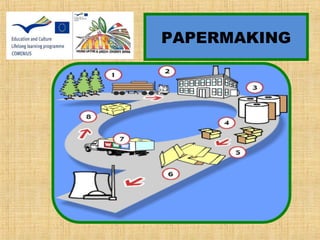Papermaking portugal
- 1. PAPERMAKING
- 2. Where does paper come from? ŌĆó We get paper from trees, more precisely from its wood. ŌĆó All the wood material in a tree is formed of fibres, tiny cellulose strands stuck together with a natural adhesive material called lignin. It's by separating and reorganizing those fibers that we make paper. ŌĆó So, fibres are the basic elements to produce paper. ŌĆó The type of paper we get depends on the type of pulp we obtain from those fibres . ŌĆó Almost all of the paper you use today is made of wood fibres. Some special papers, like stationery and money, are made from linen, cotton, or other plants. Other papers contain a combination of cellulose fibres and synthetics such as latex.
- 3. What trees are used to produce paper? ŌĆó Foresters divide trees into two categories: hardwood and softwood species. ŌĆó Hardwood trees such as oaks and maples have wood with very short fibres. Paper made from these species is weaker but its surface is smoother, and therefore better to write and print on. ŌĆó Softwood trees such as pine and spruce have wood with long fibers, and paper made from this type of wood is much stronger. But the finish is rougher, and that's not as good for writing, printing and many other uses. ŌĆó We can mix fibre from hardwoods and softwoods into a single paper, getting just the combination we want. ’üČ On average it takes 25 trees to produce 1 ton of paper
- 4. What are the first steps? ŌĆó First, workers cut trees, mostly from special tree-growing areas. After the trees are removed, more trees are planted in their place. ŌĆó The logs are transported to the paper company where they get a bath to clean the dirt and other impurities before being turned into small chips of wood. ŌĆó The chips are then sorted according to size, and moved to the pulping operation, where they will be turned into pulp for making paper.
- 5. How do we get the pulp? ŌĆó In the pulping stage, the individual wood fibres must be separated. We choose the pulping techniques according to the paper we want. ŌĆó The finished pulp looks like a mushy, watery solution. Then, it's time to make paper out of the pulp. That mainly means getting the water out, since this pulp is about 99% water. ŌĆó The first area in which this takes place is called the wet end of the papermaking machine.
- 6. The Mechanical Process ŌĆó First, papermakers spray the stock onto a long, wide screen, called a wire. ŌĆó Immediately, water begins to drain out the bottom of the wire. This water is collected so that it can be reused over and over again. ŌĆó Meanwhile, the pulp fibres are caught and begin to bond together in a very thin mat. ŌĆó The fibre mat remaining on the wire is then squeezed between felt-covered press rollers to absorb more of the water. ŌĆó Even when this wet end work is over, the pulpy stuff is still about 60% water. ŌĆó In the dry end, huge metal cylinders are heated by filling them with steam. Heating and drying the wet sheet seals the fibres closer and closer together, turning them gradually from pulp into paper.
- 7. The Whole Process: a summary
- 8. Finishing Processes ŌĆó The characteristics, appearance and properties of paper and board depend on their final treatments. ŌĆó Coated paper Coating is a process to improve brightness or printing properties by applying china clay, pigment or other products. ŌĆó Uncoated paper Uncoated paper is typically used for letterheads, copy paper, or printing paper.
- 9. How do we recycle paper? ŌĆó Sorting Successful recycling requires clean recovered paper, so you must keep your paper free from contaminants, such as food, plastic, metal, and other trash, which make paper difficult to recycle. ŌĆó Contaminated paper which cannot be recycled must be composted, burned for energy, or land filled. ŌĆó Collection and Transportation You may take your sorted paper to a local recycling center or recycling bin. ŌĆó At the recycling center, the collected paper is wrapped in tight bales and transported to a paper mill, where it will be recycled into new paper.
- 10. Why is it important to recycle paper? BEFORE NOW ŌĆó If we recycle paper, we will cut down a smaller quantity of trees and the disposal of paper is also reduced (green scheme)
- 11. OUR MESSAGE Catarina and Diogo from Portugal May 2012











